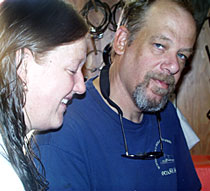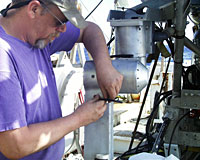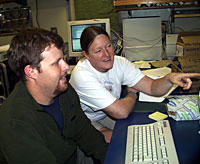|
|
Interviews: Microbiologist Anna-Louise
Reysenbach
Question:
How did you transition from piloting the submersible Alvin to piloting ROV Jason? WIll: I was with the Alvin group for five years, then I switched to Remote Operated Vehicles (ROVs) and I’ve been doing it ever since. I switched because of the sheer amount of sea time involved with Alvin - it’s eight and a half months a year. Also I was ready for a new technical challenge. Jason offered an opportunity in a higher-tech world. Question: In addition to your trip here, you have traveled together to some interesting work locations. Tell me about the other three oceanographic expeditions. Cindy: We traveled together to Italy to work with Jason for Bob Ballard exploring ancient shipwrecks. Then we went to Mexico to study hydrothermal vents in the Sea of Cortez (Gulf of California). Last summer it was hydrothermal vent work on the Juan de Fuca ridge off the coast of Seattle, Washington.
Will, since you began working for the Deep Submergence Lab, you have been on every trip Jason has made except for one, when you had hip replacement surgery. What is your schedule like? Will: Sometimes it’s brutal. I average about five months a year of sea time. Question: Will, what are your favorite seafloor areas to explore using ROV Jason? Will: I’ve been to most of the mid-ocean ridge spreading centers to explore vents in the Pacific and Atlantic, and it’s really fun stuff. But I really liked diving on the Titanic wreck and on ancient Roman shipwrecks with Bob Ballard. Question: What are your favorite parts of your work, and working together. Will: I’ve had people say to me, ‘how can you waste your life going to sea?’ But wasting your life is watching television re-runs. This is not wasting your life, exploring the deep ocean and traveling around the world. We’re lucky we get to do this together. Cindy: It’s neat because we can really empathize with each other when the other is at sea. When one person is gone and the other is at home, we truly understand each other’s sea life.
|
||||||
Mailing List | Feedback | Glossary | For Teachers | About Us | Contact
© 2010 Dive and Discover™. Dive and Discover™ is a registered trademark of
Woods
Hole Oceanographic Institution
 Will and Cindy met in 1988 at
a WHOI Christmas party and married three years later. It’s rare
that they travel and work together on oceanographic expeditions
- this Indian Ocean cruise is a special treat.
Will and Cindy met in 1988 at
a WHOI Christmas party and married three years later. It’s rare
that they travel and work together on oceanographic expeditions
- this Indian Ocean cruise is a special treat. 
